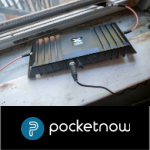Sick of having to go outside to use your cell phone? The CEL-FI Go X takes the signal from outside, boosts it, and redistributes it indoors.
For most of us tech enthusiasts and tech journalists, mobile phone reception isn’t much of an issue anymore. We kind of have to live in an area with good reception, and sometimes we forget that not everywhere has decent coverage. Everyone’s hyping up 5G as the next big thing, but take a drive to northern Maine or something and you might not even get EDGE 2G data speeds. Holidays at my aunt’s house in central Massachusetts are like that too. She has to go outside on the porch just to get one bar of signal on her iPhone with AT&T. Forget about getting calls or text messages in the living room.
What’s in the Box
The CEL-FI Go X booster comes in a very large and heavy box. That’s because there’s a lot of hardware it’s going to be a bit of a project.
In the box, we’ve got:
- CEL-FI Go X Amplifier
- Power Supply (15 Volt, 1.5 Amp)
- Quick Start and Installation Guide
- 1x RSRF Wideband Outdoor Log Periodic Antenna
- 2x RSRF SMA-male to N-female Pigtail Adapter
- RSRF 50-Ohm N-Male Lightning Surge Protector
- RSRF Universal J-Mount Antenna Mount
- 2x RSRF 30 foot RS400 Low-Loss Coaxial Cable with N-Male Connectors
- 1x Rectangular Indoor Antenna
- 1x Dome Indoor Antenna
- Various screws & mounting hardware
Before you start
Read the instructions! This is very important as set up and installation is fairly complicated. The installation guide is very helpful for getting you up to speed on what’s involved. I used the Network Cell Info Lite app on Android to measure signal strength a bit. There’s barely one bar of signal strength near the door in my aunt’s house. I have to go outside and down the driveway a bit to get a better signal. Knowing where to find a better signal outdoors is going to be important for installing the outdoor antenna, so walking around with the Network Cell Info gauge on your cell phone is a good idea.
Installation
First, find a good spot to place the CEL-FI X Go amplifier box indoors. It has mounting screw holes so you can bolt it to a wall if you want, but I’d say just lay it down somewhere first in order to test it. You’ll need to plug it into a power outlet to turn it on and then on each end, there are antenna jacks for screwing the antenna wires onto. They’re clearly labeled. One is for the outdoor antenna, and one is for the indoor antenna. To test, we just screwed all the wires together and put the outdoor antenna outside, with the indoor antenna inside, just laying on a table somewhere.
You’ll want to install the CEL-FI Go app on a phone at this point in order to see how the signal strength is getting boosted. Software setup is pretty simple. It should detect the booster within a few minutes or so and start showing some more information. The CEL-FI app also has an antenna position test utility that will let you test the signal strength of the outdoor antenna’s position. Run the test and then change the position to see if you get better results. You’ll want to point the outdoor antenna towards the nearest cell tower.
You can also use the phone software to change which carrier you want to boost the signal of. It can’t boost all of them all the time, so you’ll have to choose one. Hopefully your whole family can agree on one carrier. It takes a few minutes for the booster to switch over to different carrier bands, too, so be patient.
We found a pretty good place to put the outdoor antenna on a metal fence outside. The phones get about 2 bars of signal strength in this area, and that’s probably the best we can do considering the 30 foot length of the included wiring.
The included lightning surge protector didn’t seem to fit any of the included wires. It just wouldn’t screw in to anything. This is supposed to go between the 5ft wire and the 30ft wire outside and then another grounding wire is supposed to go to the ground in order to keep lightning surges from going into the house. We may have to call an electrician to install this properly or unplug everything when it rains.
For the indoor antenna, the idea is to run the wire through the walls or ceiling and mount it somewhere towards the center of the building. We were too lazy and unskilled for that, so the indoor antenna was just hung on the wall inside next to the booster.
By the way, there are two indoor antennas to choose from, a cone-shaped one and a rectangular one. You can’t use both at the same time as this particular booster is only made for one indoor antenna, but you can choose the one that works best in your building.
Results
After everything is installed and turned on, you’ll see some new boosting signal strength indicators in the CEL-FI phone app.
More importantly, your cell phones will now actually work indoors! Above, you can see my aunt’s iPhone now has 3 bars of signal reception on AT&T in her kitchen which is a lot more than the zero bars she used to have.
Pricing & Availability
The CEL-FI Go X booster can be found at Amazon or on Waveform.com for $1000 with one indoor antenna port. For $1150, you can get a version with two indoor antenna ports for extending signal through larger buildings. You can find a number of other distributors on the CEL-FI website here.
Pros & Cons
Pros
- Extreme increase in cellular network reception in a building that had previously dead zones
- You don’t have to go outside to check your cell phone messages
- A wide range of carriers/bands supported
- Versions available for different sized buildings
- Improves LTE data connections
Cons
- Not exactly easy to install (You might want help from an electrician)
- Only boosts one network provider at a time
- Couldn’t get the surge protector installed
- Price may be too much for some rural homes
- Doesn’t work with Sprint
- Requires a little bit of network reception outdoors
Conclusion
This signal strength extender/booster is absolutely legit. You may have seen cell phone booster scams before, but this one is the real deal. It certainly works as advertised, and for $1000 it had better. Of course, the downside is that it’s quite a lot of work to install it in your home or business. Especially with larger buildings, you may want to route the wires within the walls and mount indoor antennas to the ceiling. Still, that’s the cost of doing it correctly. Obviously, this isn’t a complete solution to rural areas with no cell network reception at all, since it requires some cell tower reception somewhere in order to be able to boost it into a building. Still, for improving cellular network quality for indoor dead zones, the CEL-FI Go X is gold!
Adam Z. Lein
Adam has had interests in combining technology with art since his first use of a Koala pad on an Apple computer. He currently has a day job as a graphic designer, photographer, systems administrator and web developer at a small design firm in Westchester, NY. His love of technology extends to software development companies who have often implemented his ideas for usability and feature enhancements. Mobile computing has become a necessity for Adam since his first Uniden UniPro PC100 in 1998. He has been reviewing and writing about smartphones for Pocketnow.com since they first appeared on the market in 2002. Read more about Adam Lein!
A version of this review was originally published by PocketNow




